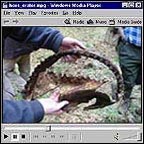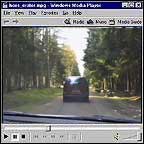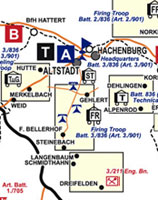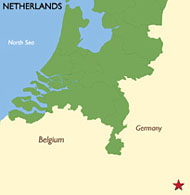| Phase Two in
Westerwald
After December 1,
1944, there were launching areas near Hillscheid and
near Gehlert. The 1./836 moved into positions
near Hillscheid, while the 3./836 occupied
newly prepared sites outside of Gehlert.
Fritz Siewczynski
and his comrades moved to new positions in the
forest (forest Oberelberter Marktwald in the district
Hillscheider Stock) three kilometers east of
Hillscheid. This was firing site #604 and it was used
by batterie 1./836 (later renamed Art.
Reg. 1./901) from December 9, 1944 until
February 25, 1945.
At Hillscheid there
were four launch platforms at this position (three concrete pads remain even
today). The sites were constructed on turnouts from
a hard surfaced road, and the firing platforms were
concrete; except for one which, was a rough plank
platform over a base of logs embedded in the ground.
The 1./836 (Art. Reg. 1./901) Technical
Troop field store for the Hillscheid positions
was located between Dernbach and Hillscheid near
Höhr-Grenzhausen in the Stadtwald. These locations
were all camouflaged by suspending branches from
wires strung high among the trees. In total, 189
V2's were fired from Hillscheid positions with 23
failures of various nature.
| (Photo 1)
Concrete pad at Hillscheid. (Photo 2) Trenches
near firing sites. (Photo 3) Rocket debris
found near the sites. (Photo 4) Concrete pad
destroyed. (Photo 5) Trenches near firing
sites. |
-
| (Photo 1)
Portion of fuel tank. (Photos 2 & 3)
Beautiful concrete pad remaining at
Hillscheid. (Photos 4 & 5) The servicing
roads near the Hillscheid sites. |
-
Things did not go so
well the next day - the 1./836 again fired two
rockets against Antwerp, one Kurzschusse (means
rocket lifts off but, goes off course) (rocket No.
20477), crashed into the road 200 meters away from the
launching site. A very large crater was torn in the
road. Because of this, it delayed operations at the
two other firing platforms, as it was not possible to
deliver A-Stoff (liquid-oxygen) and the hole blocked
the path of the Meillerwagen to at least one firing
site.
The other failure
(rocket No. 20471) did not come up to full thrust at
launch. It tilted on the firing table and toppled onto
the firing platform. The five-fold connector had not
been detached from the rocket and caused the rocket to
be pulled to one side. It was decided to drain the
remaining fuel from the crumpled rocket by using a
pick-axe to puncture the tanks. The draining fuels
ignited and exploded. Three soldiers were killed and
two others wounded. This was a great loss of material
and also ruined the firing position. After the day was
over the site was not in use any longer.
 |
Click here
to view video of the V2 launching sites at
Hillscheid. My friends and I visited the three
concrete firing pads remaining in the forest
today.
This is a
Windows Media Video file (WMV). It is 4788
KB in size. The file will stream or you can
download it completely before viewing.
Running time: 2 minutes, 51 seconds with
sound.
|
The second position in operation in
December was manned by the soldiers of the 3./836
near Gehlert. The first V2's fired from this region
lifted off on December 15, 1944, targeting Antwerp.
The site was numbered #605 and the third batterie
would eventually fire 199 V2's, the last one on
March 16, 1945.
One Gehlert launching pad was completely
destroyed on December 18 when a rocket fell back
onto the pad and the warhead exploded. There were at
least 5-6 launching points at Gehlert, only one
point can be plainly seen today.
| (Photo 1)
Awesome trees near one of the Gehlert launch
sites. (Photo 2) Up this lane was another
Gehlert firing site. (Photo 4) An impact
crater right in the middle of a troop trench
at this Gehlert firing site. |
-
After
December, the shortages of liquid-oxygen were
hampering the operations of Gruppe Süd. This
was mainly caused by the abandonment of the
Wittringen plant during the Allied advance on
December 7, 1944. The first and third batteries only
fired on average one V2 every three days.
A search for more efficient launching
positions was made on December 19, 1944. The
triangle made by the three towns of Weilburg,
Limburg and Nastatten was chosen as an appropriate
area since the new emplacements allowed for
liquid-oxygen fuel conservation and also conserved
gasoline for the battalion vehicles. Launch sites at
Gehlert and Kirburg were close enough to then share
the Brennschuss signal from one sending station. The
technical and engineering stations were also
centrally located between the new sites.
| On December 26,
1944, a Kurzschusse launched from
Gehlert firing sites crashed at Ziegenhain (20
Km's away) and one shot fired from Hillscheid
impacted at Obernau (18 Km's from firing
point). |

|
On January 1, 1945, the "Table of
Organization" was issued which, upgraded the V2
battalions to regiments. This re-organization took
place in January. The 836 Artillery Battalion
became the 901 Artillery Regiment.
On January 10, 1945,
another Kurzschusse fired by 1./901
at Hillscheid (rocket No. 20950) lifted normally from
the firing table and seemed to be on correct course.
But, experienced a visible explosion in the tail
section at about 2-3 miles high. The remaining
portions of the rocket, including the warhead, fell on
the town of Wied. The impact and explosion at the edge
of the town resulted in injuries to three local women,
roof damage to houses - doors and windows at Wied and
Höchstenbach were blown out.
On January 23, 1945, the 2./836 (2./901)
returned from experiments in the east and rejoined
the other batteries of the 836 in Westerwald. Batterie
444 left Den Haag and took over the
experiments at Buddenhagen. Because of the low
supply of liquid-oxygen, the second batterie, which
returned from the east on January 23, 1945, did not
fire again until February 28, 1945.
In this period the railway stations
involved with V2 supply operations in Westerwald
included a station at Hattert (2.5 Km's
west-northwest of Hachenburg) for unloading of
B-Stoff, a station at Hachenburg (on the northern
edge of the village) for unloading A-Stoff &
T-Stoff, a station at Korb (on eastern side of
village) for unloading B-Stoff, and the V2 rockets
were unloaded at a station near Erbach (approx. 3.4
Km's southeast of Hachenburg on the southern side of
the town). There was one Strabo crane in Erbach but,
another crane was held in reserve at another
location. All unloading stations were heavily
protected by German flak batteries.
| (Photos 1-3) Railway supply stations
in Westerwald |
-
On February 7, 1945,
two Kurzschüsse were launched by batterie 1./901
(at Hillscheid). One of these rockets, No. 21763,
lifted normally but, after 28 seconds the engine shut
off. About 80 seconds later the detonation was heard.
It impacted between Hillscheid and Höhr-Grenzhausen in
a meadow.
Another Kurzschusse
impact occurred on February 8, 1945, 150 meters
away from the launching table of batterie 3./901
(at Gehlert). That same day at Hillscheid (1./901)
a rocket lifted up only a few meters before falling
back onto the launch point. Luckily, the warhead did
not detonate.
At 01.42 hrs on
February 20, 1945, a rocket was fired from the
concrete pad of the first launching platoon (at
Hillscheid). It malfunctioned and crashed down on its
tail between the firing platforms of the second and
third platoons causing much damage.
Between Gehlert and
Alpenrod the projectiles usually flew north past
Wahlrod and made an enormous noise as they rose. Local
residents saw the rockets ascending in the east with a
fiery tail. Sometimes they came down not only on
Antwerp, but in the Eifel. That gave the name "Eifel
Fright" for them. In the middle of March a V2 came
down in the Stoeffel quarry with Enspel. Some workers
were seriously hurt.
 |
Click here
to view video of the V2 launching sites at
Gehlert and Kirburg as they look today. Not
much evidence can be seen of the past V2
activity.
This is a
Windows Media Video file (WMV). It is 4338
KB in size. The file will stream or you can
download it completely before viewing.
Running time: 2 minutes, 35 seconds with
sound.
|
In early February 1945 vehicles of the
returning 2 Battalion, Reg. 901
(formerly Batterie 2./836) were loaded onto
train cars. The soldiers of 2./901 had been
away for some months in Tuchel and Peenemünde doing
experimental shootings. After traveling for many
hours, the troops were unloaded at either Weilburg
or Aumenau. Driving over the country roads through
Grävenwiebach / Seelbach and Falkenbach they arrived
into Wirbelau. The technical troop was then located
at the sports field in Wirbelau and possibly a
second technical troop was at Seelbach. The 2./901
troops were billeted in several houses in Wirbelau.
To the west, above of the town, the
streets were closed from the crossing at Wirbelau to
the crossing at Eschenau and the complete forest
area was secured. Everywhere were armed soldiers and
signs reading - "Restricted Area". At about 400-500
meters into the forest from the main road there were
three stationary launching tables (concrete pads)
and a network of vehicle paths, which were made by
the engineering platoons. The three batteries of the
2./901 took up these positions.
Later, rockets were delivered on
Meillerwagens. It was difficult for the long
vehicles to pass through the small streets of
Wirbelau. The rockets, camouflaged in a
tan-gray-olive ragged painting, were lifted up at
the launching position, waiting on fuel. The 2./901
firing crews had lots of spare time at Wirbelau
because no rockets were ever launched from these
positions.
| At the end of February the 2./901
was again loaded onto a train at Aumenau.
Over Limburg they moved to Kirburg where,
three new launching positions were added
near Kirburg. This was firing position #313
and it was manned by the 2./901.
Between
February 28 to March 16, 1945, 19 V2's were
fired from the Kirburg area against Antwerp.
On March 15 a V2 went off course and
impacted 100 Km's downrange. Their very last
day of operations featured and "double-shot"
followed by third shot just a few minutes
later.
These
sites at Kirburg were the last firing
positions to be constructed. Map entries
tell of three firing pads, but no debris or
concrete remains today to show the spots
positively.
|
|

Click here
to view JPG map of operations in Westerwald.
PDF
|
-
| (Photos
1-4) The Kirburg sites as they look today. |
-
On March 16, the 3./836 (Art. 3./901)
fired four rockets from sites at Gehlert. That same
day the 2./836 (Art. 2./901) launched
three rockets from the new sites at Kirburg. These
were the last rockets launched from the Westerwald
area. The failing supply of fuel and Allied advance
at Remagen, caused the 836 (Art. 901) to be
the first V2 launching unit to halt operations.
In late February and March 1945, these
areas were bombed and strafed nearly every day,
several times each day by the Fighter Bombers of 9th
USAAF - on some occasions, as the US fighters were
circling Kirburg, the V2 troops launched rockets
anyway, blasting skyward in plain view of the 404th
Fighter Group pilots.
On March 19, 1945, transportation was
arranged for the 2./836 (Art. 2./901)
out of their positions. The movement was to be
carried out at night. From Kirburg to Marienberg the
unit drove to Lüneburger Heide. Soon, plans were
made for the rest of the Regiment to leave the area.
During the movement of the Work Station unit of the
Regiment (from Langenbach near Marienberg into the
area of Marburg), the truck column was damaged, so
that it was stationary on the road the whole day. It
was attacked by Allied aircraft and totally
destroyed.
The 1./836 (Art. 1./901)
was not able to load their equipment for evacuation
as the marshaling yard at Firckhofen was badly
damaged by fighter-bombers and no trains could come
in to get them. The loading of the remaining V2's
and supplies was finished in Hachenburg. Another
train, this one with B-Stoff was connected to the
Hachenburg train, but these trains were unable to
move out, as only damaged locomotives were
available. The American bridgehead at Remagen, was
increasing, but had not reach the rocket troops. The
units soon used any means possible to leave the
Westerwald area.
|




























































